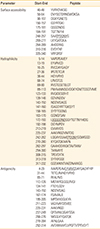1. Jain S, Kumar S, Dohre S, Afley P, Sengupta N, Alam SI. Identification of a protective protein from stationary-phase exoproteome of Brucella abortus. Pathog Dis. 2014; 70:75–83.

2. von Bargen K, Gorvel JP, Salcedo SP. Internal affairs: investigating the Brucella intracellular lifestyle. FEMS Microbiol Rev. 2012; 36:533–562.

3. Sung KY, Jung M, Shin MK, et al. Induction of immune responses by two recombinant proteins of brucella abortus, outer membrane proteins 2b porin and Cu/Zn superoxide dismutase, in mouse model. J Microbiol Biotechnol. 2014; 24:854–861.

4. Gwida M, Al Dahouk S, Melzer F, Rosler U, Neubauer H, Tomaso H. Brucellosis: regionally emerging zoonotic disease? Croat Med J. 2010; 51:289–295.
5. Lopes LB, Nicolino R, Haddad JP. Brucellosis: risk factors and prevalence: a review. Open Vet Sci J. 2010; 4:72–84.
6. Avila-Calderon ED, Lopez-Merino A, Sriranganathan N, Boyle SM, Contreras-Rodriguez A. A history of the development of Brucella vaccines. Biomed Res Int. 2013; 2013:743509.
7. Perkins SD, Smither SJ, Atkins HS. Towards a Brucella vaccine for humans. FEMS Microbiol Rev. 2010; 34:379–394.
8. Salhi I, Boigegrain RA, Machold J, Weise C, Cloeckaert A, Rouot B. Characterization of new members of the group 3 outer membrane protein family of Brucella spp. Infect Immun. 2003; 71:4326–4332.

9. Cloeckaert A, Vizcaino N, Paquet JY, Bowden RA, Elzer PH. Major outer membrane proteins of Brucella spp.: past, present and future. Vet Microbiol. 2002; 90:229–247.

10. Paquet JY, Diaz MA, Genevrois S, et al. Molecular, antigenic, and functional analyses of Omp2b porin size variants of Brucella spp. J Bacteriol. 2001; 183:4839–4847.

11. He Y, Xiang Z. Bioinformatics analysis of Brucella vaccines and vaccine targets using VIOLIN. Immunome Res. 2010; 6:Suppl 1. S5.

12. Laloux G, Deghelt M, de Barsy M, Letesson JJ, De Bolle X. Identification of the essential Brucella melitensis porin Omp2b as a suppressor of Bax-induced cell death in yeast in a genome-wide screening. PLoS One. 2010; 5:e13274.

13. Higgins DG, Bleasby AJ, Fuchs R. CLUSTAL V: improved software for multiple sequence alignment. Comput Appl Biosci. 1992; 8:189–191.

14. Petersen TN, Brunak S, von Heijne G, Nielsen H. SignalP 4.0: discriminating signal peptides from transmembrane regions. Nat Methods. 2011; 8:785–786.

15. Persson B, Argos P. Topology prediction of membrane proteins. Protein Sci. 1996; 5:363–371.

16. Gasteiger E, Hoogland C, Gattiker A, et al. Protein identification and analysis tools on the ExPASy Server. In : Walker JM, editor. The proteomics protocols handbook. Totowa: Humana Press Inc.;2005. p. 571–607.
17. Sen TZ, Jernigan RL, Garnier J, Kloczkowski A. GOR V server for protein secondary structure prediction. Bioinformatics. 2005; 21:2787–2788.

18. Zhang Y. I-TASSER server for protein 3D structure prediction. BMC Bioinformatics. 2008; 9:40.

19. Wiederstein M, Sippl MJ. ProSA-web: interactive web service for the recognition of errors in three-dimensional structures of proteins. Nucleic Acids Res. 2007; 35:W407–W410.

20. Lovell SC, Davis IW, Arendall WB 3rd, et al. Structure validation by Calpha geometry: phi,psi and Cbeta deviation. Proteins. 2003; 50:437–450.

21. Wang P, Sidney J, Kim Y, et al. Peptide binding predictions for HLA DR, DP and DQ molecules. BMC Bioinformatics. 2010; 11:568.

22. El-Manzalawy Y, Dobbs D, Honavar V. Predicting linear B-cell epitopes using string kernels. J Mol Recognit. 2008; 21:243–255.

23. Ponomarenko J, Bui HH, Li W, et al. ElliPro: a new structure-based tool for the prediction of antibody epitopes. BMC Bioinformatics. 2008; 9:514.

24. Golshani M, Rafati S, Jahanian-Najafabadi A, et al. In silico design, cloning and high level expression of L7/L12-TOmp31 fusion protein of Brucella antigens. Res Pharm Sci. 2015; 10:436–445.



















